
Brian Wilson Aldiss was an English writer, artist and anthology editor, best known for science fiction novels and short stories. His byline reads either Brian W. Aldiss or simply Brian Aldiss, except for occasional pseudonyms during the mid-1960s.

James Benjamin Blish was an American science fiction and fantasy writer. He is best known for his Cities in Flight novels and his series of Star Trek novelizations written with his wife, J. A. Lawrence. His novel A Case of Conscience won the Hugo Award. He is credited with creating the term "gas giant" to refer to large planetary bodies.
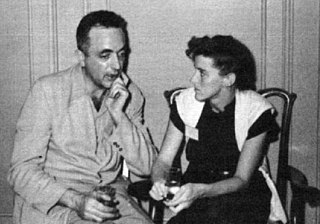
Katherine Anne MacLean was an American science fiction author best known for her short fiction of the 1950s which examined the impact of technological advances on individuals and society.

Damon Francis Knight was an American science fiction author, editor, and critic. He is the author of "To Serve Man", a 1950 short story adapted for The Twilight Zone. He was married to fellow writer Kate Wilhelm.
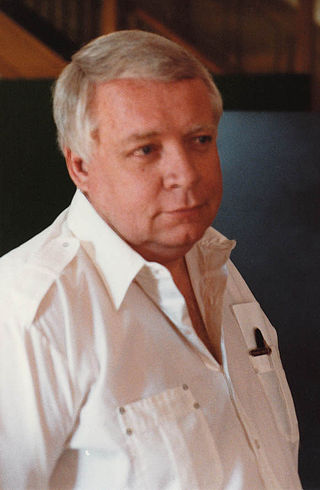
Algirdas Jonas "Algis" Budrys was a Lithuanian-American science fiction author, editor, and critic. He was also known under the pen names Frank Mason, Alger Rome, John A. Sentry, William Scarff, and Paul Janvier. He is known for the influential 1960 novel Rogue Moon.
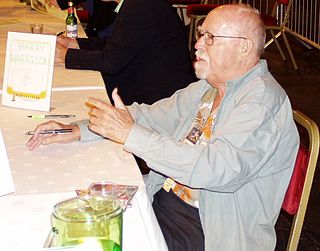
Harry Max Harrison was an American science fiction author, known mostly for his character The Stainless Steel Rat and for his novel Make Room! Make Room! (1966). The latter was the rough basis for the motion picture Soylent Green (1973). Long resident in both Ireland and the United Kingdom, Harrison was involved in the foundation of the Irish Science Fiction Association, and was, with Brian Aldiss, co-president of the Birmingham Science Fiction Group.
Arthur Bertram Chandler was an Anglo-Australian merchant marine officer, sailing the world in everything from tramp steamers to troop ships, but who later turned his hand to a second career as a prolific author of pulp science fiction. He also wrote under the pseudonyms of George Whitley, Andrew Dunstan and S.H.M. Many of his short stories draw on his extensive sailing background. In 1956, he emigrated to Australia and became an Australian citizen. By 1958 he was an officer on the Sydney-Hobart route. Chandler commanded various ships in the Australian and New Zealand merchant navies, including his service as the last master of the Australian aircraft carrier HMAS Melbourne; by law, the ship was required to have an officer on board while awaiting its towing to China to be broken up. Chandler wrote over 40 novels and 200 works of short fiction, winning the Australian Ditmar Awards for the short story "The Bitter Pill" and for three novels: False Fatherland, The Bitter Pill, and The Big Black Mark. One of Chandler's daughters, Jenny Chandler, married British horror fiction writer Ramsey Campbell. His other children were Penelope Anne Chandler and Christopher John Chandler.
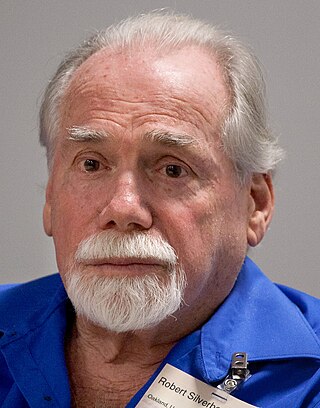
Robert Silverberg is an American author and editor, best known for writing science fiction. He is a multiple winner of both Hugo and Nebula Awards, a member of the Science Fiction and Fantasy Hall of Fame, and a Grand Master of SF. He has attended every Hugo Award ceremony since the inaugural event in 1953.
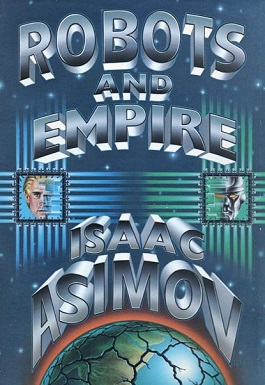
Robots and Empire is a science fiction novel by the American author Isaac Asimov, published by Doubleday Books in 1985. It is part of Asimov's Robot series, which consists of many short stories and five novels.
"Blind Alley" is a science fiction short story by American writer Isaac Asimov. It was first published in the March 1945 issue of Astounding Science Fiction, and later included in the collection The Early Asimov (1972).

The City and the Stars is a science fiction novel by British writer Arthur C. Clarke, published in 1956. This novel is a complete rewrite of his earlier Against the Fall of Night, Clarke's first novel, which had been published in Startling Stories magazine in 1948 after John W. Campbell, Jr., editor of Astounding Science-Fiction, had rejected it, according to Clarke.
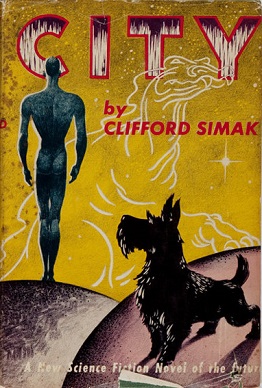
City is a 1952 science fiction fix-up novel by American writer Clifford D. Simak. The original version consists of eight linked short stories, all originally published in Astounding Science Fiction under the editorship of John W. Campbell between 1944 and 1951, along with brief "notes" on each of the stories. These notes were specially written for the book, and serve as a bridging story of their own. The book was reprinted as ACE #D-283 in 1958, cover illustration by Ed Valigursky.

Against the Fall of Night is a science fiction novel by British writer Arthur C. Clarke. Originally appearing as a novella in the November 1948 issue of the magazine Startling Stories, it was revised and expanded in 1951 and published in book form in 1953 by Gnome Press. It was later expanded and revised again and published in 1956 as The City and the Stars. A later edition includes another of Clarke's early works and is titled The Lion of Comarre and Against the Fall of Night. In 1990, with Clarke's approval, Gregory Benford wrote a sequel titled Beyond the Fall of Night, which continues the story arc of the 1953 novel. It is generally printed with the original novel as a single volume.

Non-Stop is a 1958 science fiction novel by British writer Brian Aldiss. It is about problems that the inhabitants of a huge generation space ship face after an alien amino acid that they picked up on another planet triggers a pandemic. Law and order began to collapse, and knowledge of the ship and of its purpose was eventually almost entirely lost throughout the vessel.
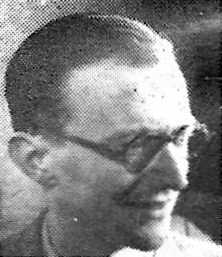
James Murdoch MacGregor was a Scottish journalist and author best known for writing science fiction under the pen name J.T. McIntosh.
"Gene Hive" is a science fiction short story by English author Brian Aldiss. It was first published, as "Journey to the Interior", in 1958 in Nebula Science Fiction #30 and first collected, as "Gene-Hive", in The Canopy of Time

Nebula Science Fiction was the first Scottish science fiction magazine. It was published from 1952 to 1959, and was edited by Peter Hamilton, a young Scot who was able to take advantage of spare capacity at his parents' printing company, Crownpoint, to launch the magazine. Because Hamilton could only print Nebula when Crownpoint had no other work, the schedule was initially erratic. In 1955 he moved the printing to a Dublin-based firm, and the schedule became a little more regular, with a steady monthly run beginning in 1958 that lasted into the following year. Nebula's circulation was international, with only a quarter of the sales in the United Kingdom; this led to disaster when South Africa and Australia imposed import controls on foreign periodicals at the end of the 1950s. Excise duties imposed in the UK added to Hamilton's financial burdens, and he was rapidly forced to close the magazine. The last issue was dated June 1959.

Clifford Donald Simak was an American science fiction writer. He won three Hugo Awards and one Nebula Award. The Science Fiction Writers of America made him its third SFWA Grand Master, and the Horror Writers Association made him one of three inaugural winners of the Bram Stoker Award for Lifetime Achievement.

Galactic Derelict is a science fiction novel by American writer Andre Norton, the second in her Time Traders series. It was first published in 1959, and as of 2012, had been reprinted in eight editions. It is part of Norton's Forerunner universe.
This is an incomplete list of works by American space opera and science fiction author Frederik Pohl, including co-authored works.
















